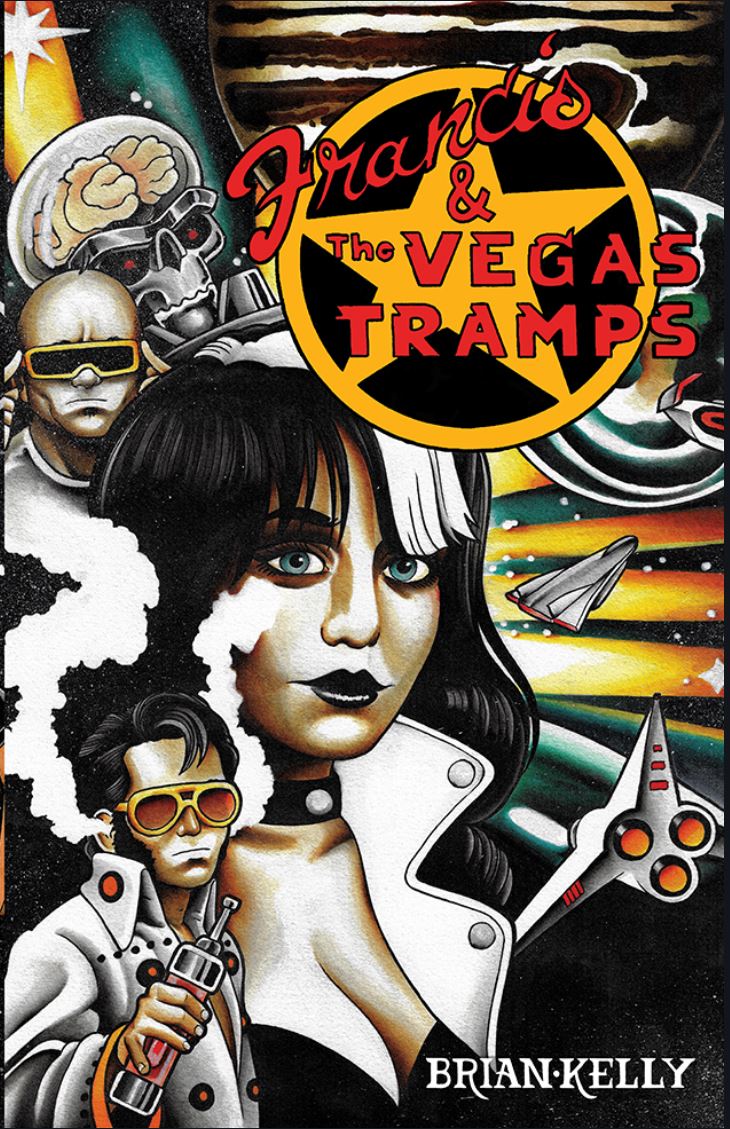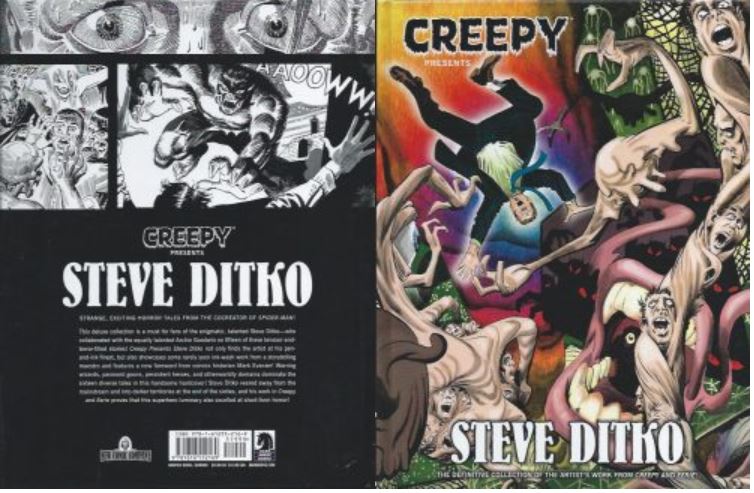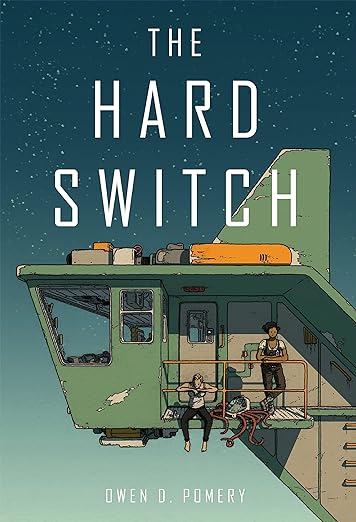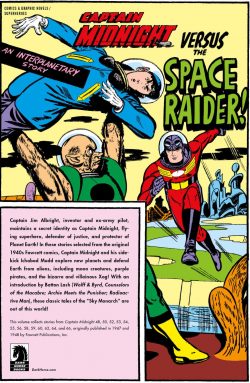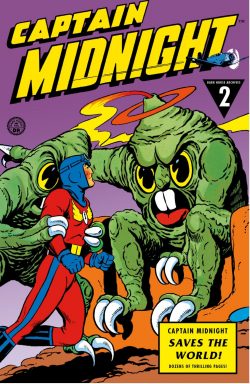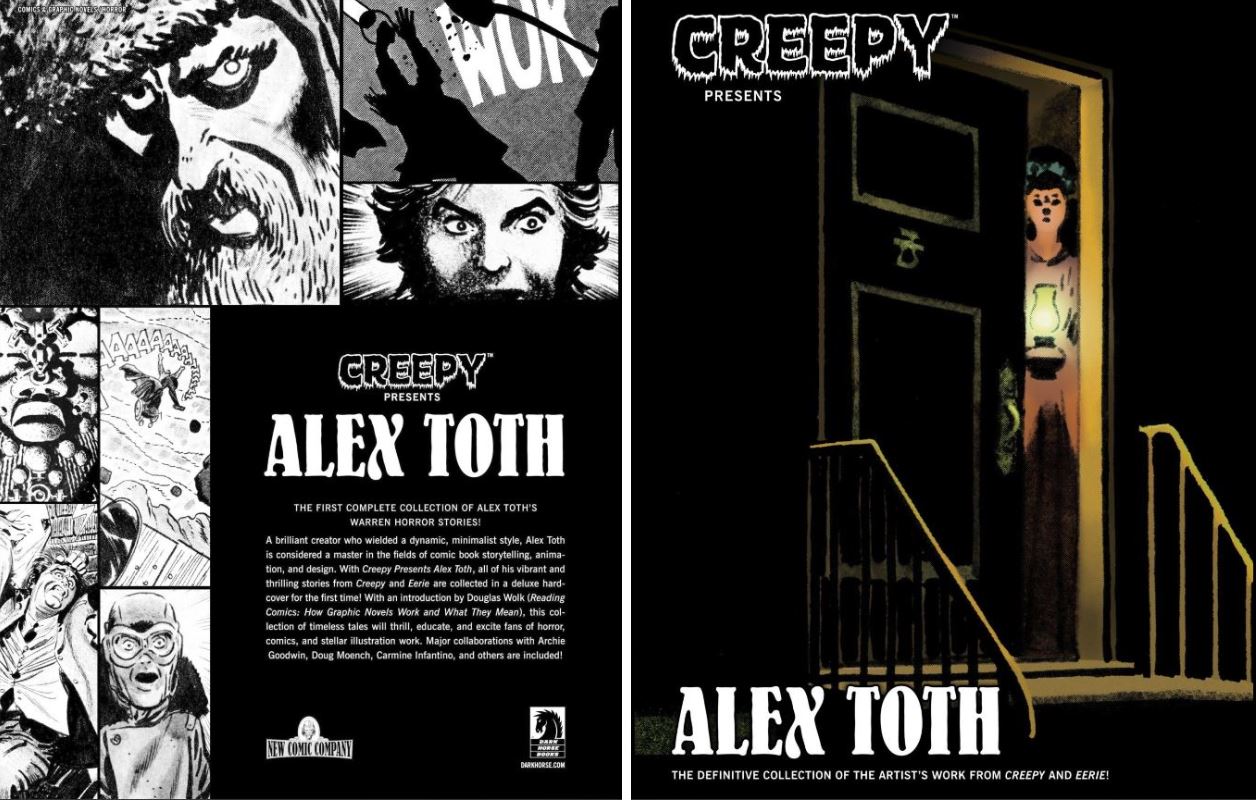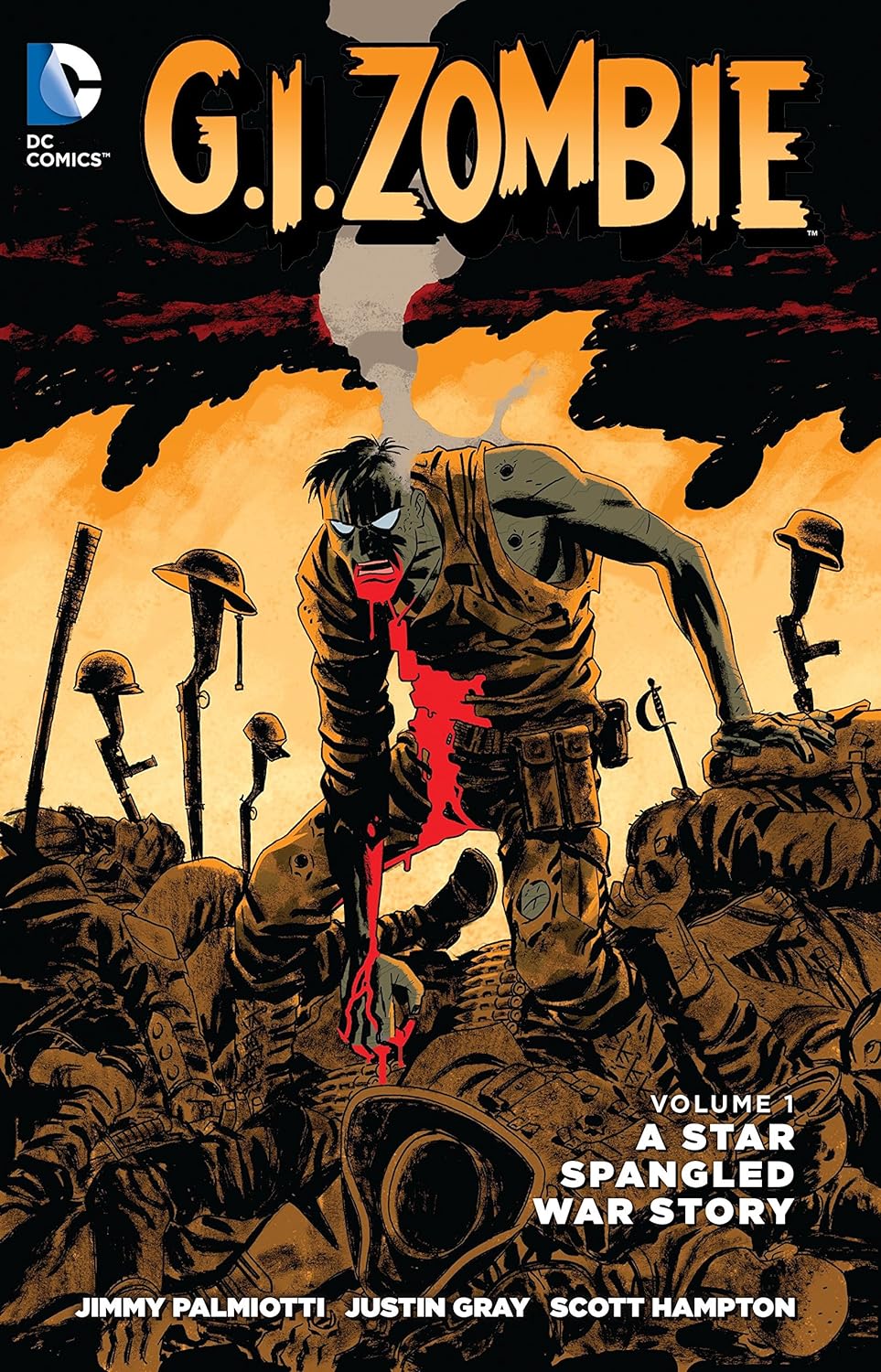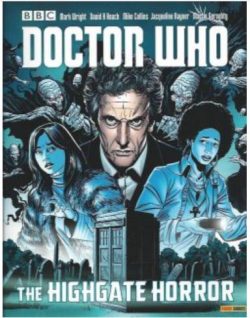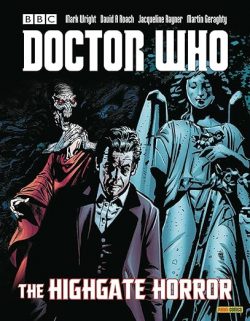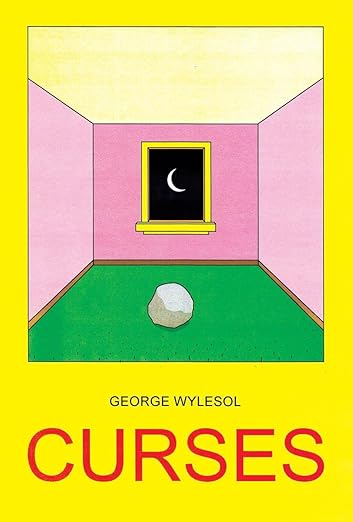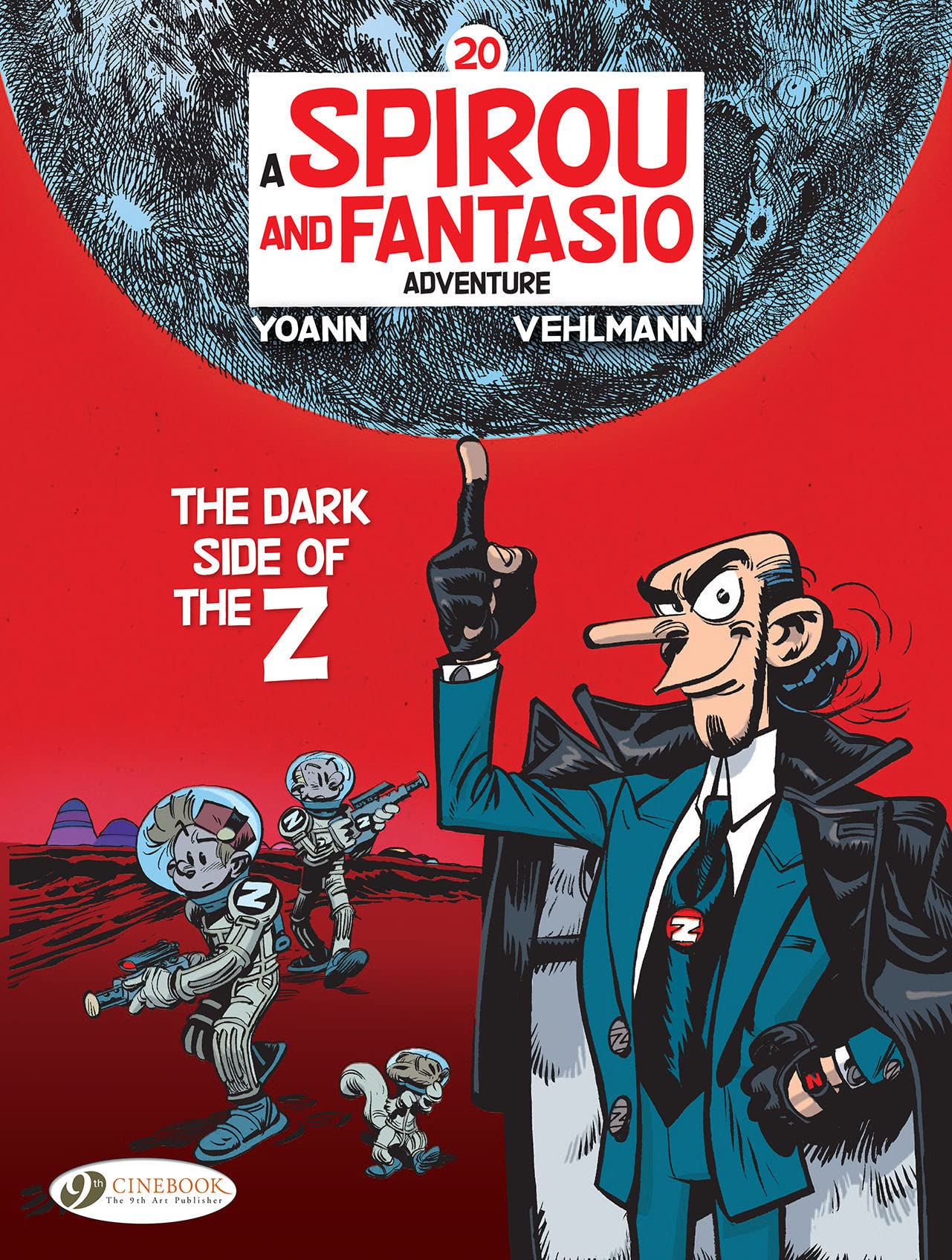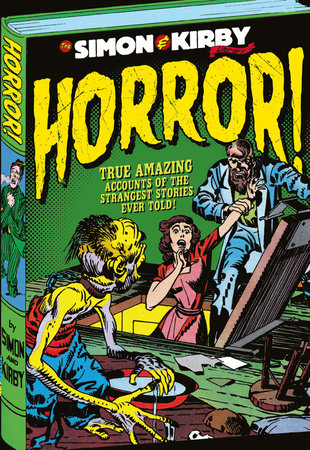
By Joe Simon, Jack Kirby, Mort Meskin and various (Titan Books)
ISBN13: 978-1-84856-959-1 (HB)
After too many years left languishing, there’s now a majority of magnificent Jack Kirby material available like this splendidly sumptuous Simon & Kirby Library gathering the iconic team’s groundbreaking contributions to the genre of mystery, suspense and the supernatural.
Kirby’s collaborations with fellow industry pioneer Joe Simon always produced dynamite concepts, unforgettable characters, astounding stories and huge sales no matter what genre avenues they pursued (they actually invented the Romance comic book), blazing trails for so many others to follow and always reshaping the very nature of American comics with their innovations and sheer quality.
Comic books started slowly and tenuously in 1933, until Superman’s debut unleashed a torrent of creative imitation and invented a new genre: Superheroes. Implacably vested in the Second World War, the masked mystery man swept all before him (very occasionally her or it) until the troops came home and older genres supplanted the Fights ‘n’ Tights crowd.
Although new kids kept up the buying, much of the previous generation also retained their four-colour habit but increasingly sought more mature themes in the reading matter. The war years altered the psychology of society and a more world-weary, cynical reading public came to see that all the fighting and dying hadn’t really changed anything. Their chosen forms of entertainment – film and prose as well as comics – increasingly reflected this.
Western, War and Crime comics, madcap teen comedy and anthropomorphic funny animal features were immediately resurgent, the aforementioned Romance comics appeared in 1947 and pulp-style Science Fiction began to spread, but gradually another global revival of spiritualism and interest in the supernatural (possibly provoked by the monstrous losses of the recent conflict, just as had happened in the 1920s following WWI) led to a wave of increasingly impressive, evocative and even shocking horror comics.
There were grisly, gory and supernatural stars before, including a pantheon of ghosts, monsters and wizards draped in costumed hero trappings (The Spectre, Mr. Justice, The Heap, Frankenstein, Zatara, Dr. Fate and dozens of others), but these had been victims of circumstance: the Unknown as power source for super-heroics. Now focus shifted to ordinary mortals thrown into a world beyond their ken with the intention of unsettling, not vicariously empowering, the reader.
Almost every publisher jumped onto the monumentally popular juggernaut, but B & I (which became magical one-man-band Richard E. Hughes’ American Comics Group) released the first regularly published horror comic with Adventures Into the Unknown in the autumn of 1948. Technically it was pipped by Avon whose one-shot Eerie debuted and closed in January 1947. They wised up later, and launched a regular series in 1951. By this time Classics Illustrated had already long milked the literary end of the medium: adapting The Headless Horseman, Dr. Jekyll and Mr. Hyde (both 1943), The Hunchback of Notre Dame (1944) and Frankenstein (1945) among others.
At this time Joe & Jack identified another “mature market” gap for the line of magazines they autonomously packaged for publishers Crestwood-Prize-Essenkay: Headline Comics, Justice Traps the Guilty, Police Trap, Young Romance and other anthologies. They too saw the sales potential for spooky material, resulting in the superb and eerily seminal Black Magic (launched with an October-November 1950 cover-date) and the boldly obscure psychological drama anthology Strange World of Your Dreams in1952.
Marvel had jumped on the bloody bandwagon early but National/DC Comics only reluctantly bowed to the inevitable, launching a comparatively straight-laced short story title that nevertheless became one of their longest-running and most influential titles with the launch of The House of Mystery (December 1951/January 1952). Soon after, however, a hysterical censorship scandal led to witch-hunt Hearings (just type Senate Subcommittee on Juvenile Delinquency, April-June 1954 into your search engine at any time) which panicked most comics publishers into adopting a castrating straitjacket of self-regulatory rules…
Just like today, America back then cast about wildly looking for external contaminants rather than internal causes for a perceived shift in social attitudes and youthful rebellion, happily settling on bloodthirsty comics about crime or horror, drenched in unwholesome salacious sex, as the reason their children were talking back, acting up and staying out.
S&K didn’t do those kinds of comic books but they got tarred – and metaphorically feathered too – in the media-fuelled frenzy…
This striking full-colour hardback begins with essay ‘That Old Black Magic’ by series editor Steve Saffel, delineating the title’s history and tone of the times whilst ‘Simon and Kirby’s Little Shop of Horror’ describes the working of the small but prolific studio of rotating artists who augmented the output of the named stars: creators such as Mort Meskin, Bill Draut, Martin Stein, Ben Oda, George Roussos, Vic Donahue, Bill Walton, Jim Infantino, Bruno Premiani, John Prentice, Jerry Grandenetti and more. With a vast output across many titles, S&K simply couldn’t produce every story and many yarns here are ghosted by other hands, although each and every one does begin with a stunning Kirby splash panel.
As with all their titles, Simon & Kirby offered genre material tweaked by their own special sensibilities. Black Magic – and the Mort Meskin-inspired The Strange World of Your Dreams – eschewed cheap shocks, mindless gore and goofy pun-inspired twist-ending yarns in favour of dark, oppressive suspense soaked in psychological unease and inexplicable unease: tension over teasing…
The stories presented fantastic situations and too frequently for comfort there were no happy endings, pat cosmic justice or calming explanations: sometimes the Unknown just blew up in your face and you survived or didn’t… and never whole or unchanged.
The compendium of black cartoon cavortings commences with ‘Last Second of Life!’ (from volume 1 #1, October-November 1950) wherein a rich man obsessed over what the dying see at the final breath, but learned to regret the unsavoury lengths he went to finding out, after which ‘The Scorn of the Faceless People!’ (#2 December 1950-January 1951) relates the meaning behind a chilling nightmare. It’s not hard to believe this one must have prompted the creation of the spin-off Strange World of Your Dreams. Issue #2 also provided a chilling report on a satanic vestment dubbed ‘The Cloak!’ whilst an impossible love in the icy wastes of Canada ended with ‘A Silver Bullet for Your Heart!’ in #3 (February-March 1951).
Issue #4 provided ‘Voodoo on Tenth Avenue’ as a disgruntled wife went too far in her quest to get rid of her man, whilst in #5 ‘The World of Spirits’ recounted the uncanny predictions of Emanuel Swedenborg in a brief fact-feature before #6 described psychic connection and a ‘Union with the Dead!’ and a ravaged mariner survived meeting ‘The Thing in the Fog!’ (#7) – an encounter with the legendary Flying Dutchman…
Black Magic #8 (December 1951-January 1952) detailed the sacrifice a woman made to save her man from ‘Donovan’s Demon!’ (mostly illustrated by Bob McCarty) whilst ‘Dead Man’s Lode!’ (#10 March 1952 – the series now being monthly) related a ghostly experience in an old mine and ‘The Girl Who Walked on Water!’ in #11 showed the immense but fragile power of self-belief…
Meskin & Roussos illustrated #12’s ‘A Giant Walks the Earth!’ as a downed pilot lost his best friend to a roving colossus in India, after which the utterly chilling and unforgettable ‘Up There!’ kicks off three stories from the landmark 13th issue…
That saga of a beguiling siren of the upper stratosphere is followed by ‘A Rag – a Bone and a Hank of Hair!’ (Meskin) and a pile of trash that learned to love, whilst ‘Visions of Nostradamus!’ (by Al Eadeh) tracked and interpreted the prognosticator’s predictions.
‘The Angel of Death!’ in #15 detailed a horrific medical mystery and ‘Freak!’ (#17, possibly by Bill Draut) exposed a country doctor’s deepest shame.
Black Magic #18 (November 1952) is another multi-threat issue. ‘Nasty Little Man!’ gets my vote for scariest horror art job of all time and saw three hobos discover to their everlasting regret why you shouldn’t pick on short old men with Irish accents.
Then ‘Come Claim My Corpse’ (Martin Stein?) offers a short, sharp, shocker wherein a convict discovers too late the flaw in his infallible escape plan, before an investigator tracing truck-wreckers learns of ‘Detour Lorelei on Highway 52’ (McCarty)…
‘Sammy’s Wonderful Glass!’ in #19 (December 1952) outlined the tragic outcome of a retarded lummox whose favourite toy could expose men’s souls, after which two shorts from #20 (January 1953) follow. ‘Birth After Death’ retold the reputedly true story of how Sir Walter Scott‘s mother survived premature burial, whilst ‘Oddities in Miniature: The Strangest Stories Ever Told!’ offered half a dozen uncanny tales on one page.
Issue #21 provided ‘The Feathered Serpent’ in which an American archaeologist uncovers the truth about an ancient god, #22 (March 1953) slipped into sci-fi morality play mode with the UFO yarn ‘The Monsters on the Lake!’, and ‘Those Who Are About to Die!’ from #23 sketched out the tale of a painter who could predict imminent doom…
A brace of tales from #24 – May 1953 – begin with a scholar who attempts to contact the living ‘After I’m Gone!’, complemented by the half page fact feature ‘Strange Predictions’ (Harry Lazarus) after which ‘Strange Old Bird!’ is the first of three stories from the (again bimonthly) Black Magic #25 (June-July 1953).
In this gently eerie thriller a little old lady gets the gift of life from her tatty old feathered friend, whilst ‘The Human Cork!’ precis’ the life of the literally unsinkable Angelo Faticoni , before a man without a soul escapes the morgue to become ‘A Beast in the Streets!’
There’s a similar surfeit of sinister riches from #26, beginning with ‘Fool’s Paradise!’ wherein a cheap bag-snatcher makes a deal with the devil, after which ‘The Sting of Scorpio!’ sees a rude sceptic wish she’d never taunted a fortune teller, whilst ‘The Strange Antics of the Mystic Mirror!’ terrified nurses in a major metropolitan hospital and ‘Demon Wind!’ (Kirby inked by Premiani) finds a brash Yankee learning not to mock the justice system of primitive native peoples…
‘The Cat People’ (#27) mesmerised and forever marked an unwary tourist in rural Spain, and the same issue exposed a seductive Scottish supernatural shindig hosted by ‘The Merry Ghosts of Campbell Castle’, whilst #28 saw an unwilling organ donor return to take back his property in ‘An Eye For an Eye!’ after which the same issue revealed with mordant wit how a mummy returned to make his truly beloved ‘Alive After Five Thousand Years!’…
From an issue actually cited during the anti-comic book Senate Hearings, ‘The Greatest Horror of Them All!’ (#29 March-April 1954) told a tragic tale of a freak hidden amongst freaks, before Black Magic #30 revealed the appalling secret of ‘The Head of the Family!’ (Kirby & Premiani) whilst #31 provided both alien invasion horror ‘Slaughter-House!’ and the cautionary tale of a child raised by beasts in ‘Hungry as a Wolf!’ (Ernie Schroeder).
‘Maniac!’ from #32 is another artistic tour de force and a tale much “homaged” in later years, detailing how a loving brother stops villagers taking his simple-minded sibling away, and the Black Magic section concludes with a terrifying fable of atomic radiation and mutated sea creatures in ‘Lone Shark’ from #33 November-December 1954.
With the sagacious, industry-hip, quality-conscious Simon & Kirby undoubtedly seeing the writing on the wall, their uniquely macabre title was wisely cancelled in 1954, not long before the Comics Code came into effect. A bowdlerised version was relaunched in 1957, long after they had dissolved their partnership and moved into different areas of the industry.
However the eerie treats don’t end as a short but sublime sampling from their other mystery title is appended here.
‘We Will Buy Your Dreams’ discusses features and stories from abortive and revolutionary title The Strange World of Your Dreams, inspired by studio-mate Mort Meskin’s vivid night terrors. The premise involved parapsychologist Richard Temple explaining and analysing storied nightmares and pictorially dramatizing dreams sent in by readers.
The too short comics section then begins with ‘Send Us Your Dreams’ from #1 (August 1952), a “typical” insecurity nightmare and the chilling ‘I Talked with my Dead Wife!’, whilst #2 (September-October) provided a trio of träumen tales: ‘The Girl in the Grave!’, a scary wedding scenario in ‘You Sent Us This Dream!’ and ‘Send Us Your Dreams’ in which Dr. Tempe describes the extent of self-preservation imagery…
‘The Woman in the Tower!’ came from #3 (November-December) and detailed typical symbolism whilst ‘You Sent Us this Dream’ from the same issue explains away a nightmare climb up an unending tower. Capping off everything is a spectacular Cover Gallery reprinting Black Magic #1 through #33 plus a stunning unpublished cover, performing the same service for The Strange World of Your Dreams #1-4, and including the unpublished #5 just to make our lives utterly complete.
The Simon & Kirby Library: Horror! is a gigantic compendium of classic dark delights that perfectly illustrates the depth and scope of their influence and innovation, and readily displays the sheer bombastic panache and artistic virtuosity they brought to everything they did. This tremendous hardcover is a worthy, welcome introduction to their unique comics contributions, but there’s loads left still to see so let’s have some more please…
© 2014 Joseph H. Simon and the Estate of Jack Kirby. All Rights Reserved.

